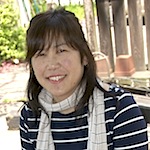A Project for Community Involvement
 The Japan Forum > Click Nippon > Creative Lesson Planning
The Japan Forum > Click Nippon > Creative Lesson Planning
A Project for Community Involvement
Inahara Kyoko
Japanese-language Teacher (High School, the American School in Japan)
2012.10.22
I am sometimes asked, "Sensei, why did you become a teacher?" I generally reply half-jokingly, "To meet superb students like you of course". Sometimes I ask myself the same question. I've been a Japanese Language teacher for 10 plus years, and I am still always frantically busy with preparing for classes. Why did I become a teacher? Am I doing the best for the students? I have asked myself these questions many times.
What and how should I teach?
While technical concepts such as 21st Century Skills, Backward Design, Multiple Intelligence, etc. cloud my mind, I struggle with how to teach the day's grammar and kanji. Different to back when I was teaching a Japanese program by myself, I now have to think carefully about the connection with the level preceding and following, and dealing with the levels of students from various backgrounds which is different each time. I know that I need to keep in mind choosing teaching materials relevant to their future, and carefully think about how to guide them, but what about my daily lesson plan?
At first, I started teaching seniors at the American School. Except for honorific form usage, they already had the fundamentals of grammar. They had already done projects covering family, food, fashion and other contemporary topics in their previous years, but I constantly wondered whether they really had the confidence in their usage of Japanese. They have the benefit of being in Japan, yet I had the feeling that they didn't interact much with Japanese people.
I leisurely thought about this off and on, that is until the 3/11 Tohoku earthquake. The devastation of the disaster left scars on us all, yet the volunteerism from not only within Japan but from other countries, really touched me showing me the goodheartedness of people.
I wondered if there was something that I could do, just even something small to help... and then I thought of a project. By the way, I always seem to come up with such ideas spontaneously; in the shower, while driving, at random times. I usually have something in my subconscious which slowly rises to the surface.
I decided to name the project "Making a Difference."
First, the students come up with a theme that interests them, and then they think about how they can contribute to the theme. For example, American School students volunteering on the weekend to be English tutors to children in Fukushima. The students need to think about what to teach, how to split the children into groups, how to interact with the people of Fukushima, getting the children's feedback, etc. The students have to think about the process from beginning to end in Japanese and document the experience. Documentation includes taking video, pictures, conducting surveys of the children, etc.
At the end of the project, the students would report on what they did, why they did it and what impact it had. My role as a teacher is nothing more than their supporter. I will review their email requests for interviews, show them how to look up difficult kanji they come across in their research, etc. This is actually quite difficult because the tendency is for me to want to give them the answer. Teaching is about leading students to the answer, not providing it to them, and thus giving them the feeling that they accomplished it by themselves, giving them their confidence.
 |
Inahara Kyoko |
|---|---|
| Japanese-language Teacher (High School, the American School in Japan) | |
Ms. Inahara grapples constantly with the questions of what skills students will need when they become adult members of society and how activities in Japanese-language class can develop those skills. Regarding her role as that of a facilitator, she incorporates a variety of activities into her lessons with the aim of bringing out the students’ latent abilities. |
Making Personal connections with Global Issues
Yoko Nishimura-Parke
A Project for Community Involvement
Inahara Kyoko